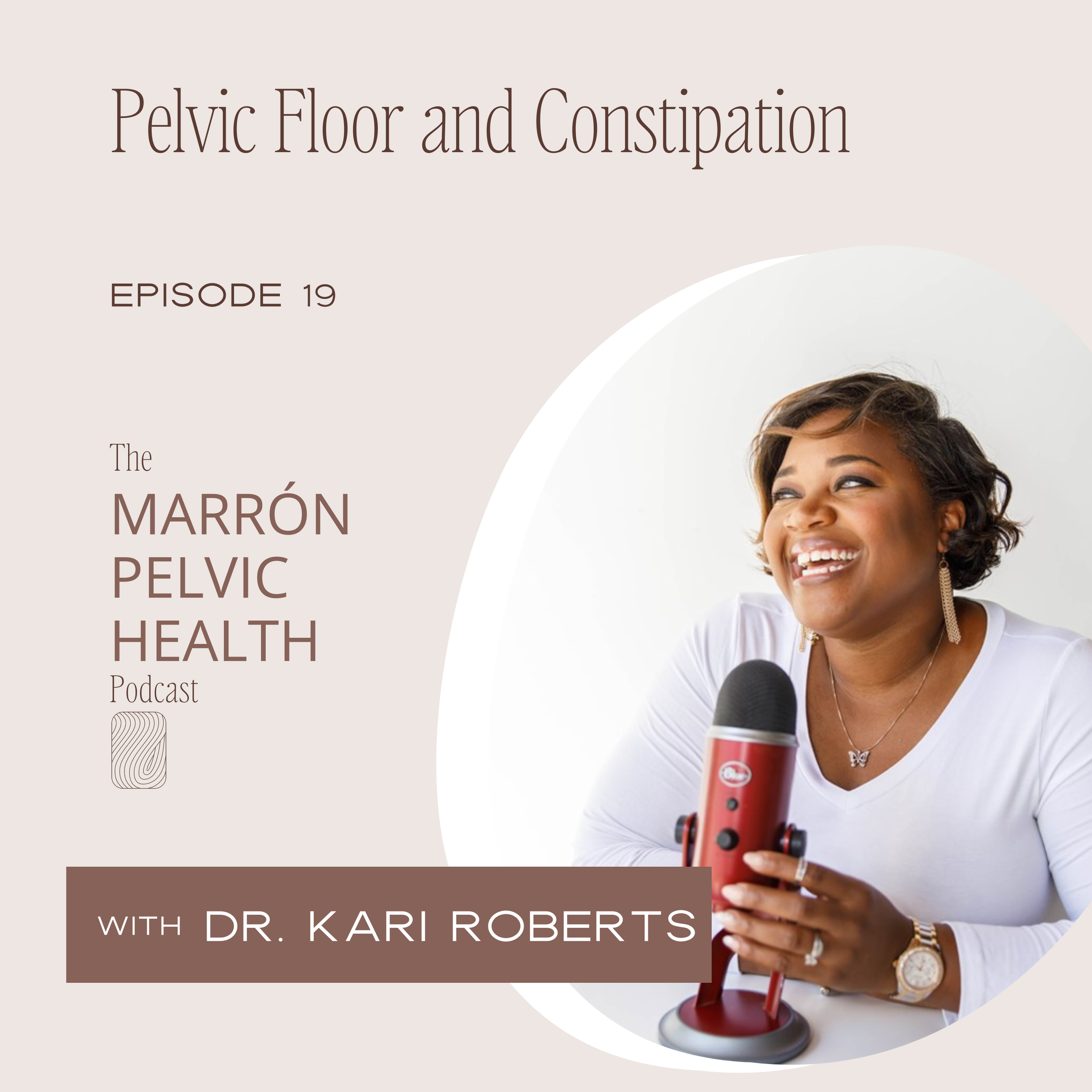Pelvic Floor and Constipation - Episode 19
The podcast episode delves into the intricate relationship between pelvic floor muscles and constipation. By explaining how the pelvic floor muscles, particularly the puborectalis, impact bowel movements, the host sheds light on how dysfunction in these muscles can lead to constipation. Through pelvic floor therapy, individuals can address issues such as muscle coordination, overactivity, and improper habits that contribute to constipation. Emphasizing the importance of seeking help from a pelvic floor physical therapist, the episode advocates for a holistic approach to managing constipation. By uncovering the connection between pelvic health and constipation, the episode aims to empower individuals to address their bowel issues effectively.
-
Dr. Kari: Welcome to the Marone Pelvic Health podcast. Hi, I'm your host, Doctor Kerry Roberts. On this show, we will be discussing a variety of things regarding your pelvic health. These conversations will be a mix of education, personal experiences, and a blend of tips you can apply to have a healthier pelvis. The goal of this show is to normalize conversations around pelvic health and help women stop suffering in silence. Hello. Welcome back. Today we're going to talk all about how the pelvic floor is related to constipation. Why are we talking about constipation? A lot of times when people think about pelvic floor physical therapy, they think about pregnancy issues, postpartum issues. Sometimes people think of back pain or hip pain. Other times, people think about pain with intercourse, pain with sex, tailbone pain. What does constipation and all of that have to do with it? Well, in a nutshell, pelvic floor therapists, pelvic floor therapy, we specialize for everything kind of in the pelvis and around the pelvis and inside of the pelvis in a female, then you have three holes. There is a hole for your urethra where you pee. There's a hole for your ****** where you have intercourse or have a baby. And there is a third hole where you, you have an **** or you defecate. For males, you have two holes, one hole for the urethra, one hole for the **** for defecation. So since those that hole is actually through the pelvic floor, it makes perfect sense that pelvic floor physical therapy would help someone with that issue. And let's kind of go through how that is related. And for those of you watching the video, I've got Phyllis here. Phyllis, the pelvis. And I'm going to use her as a visual aid to diagram what the pelvic floor is and how, what it has to do with bowel movements and how it's related to constipation. So here is the pelvic floor, and your pelvic floor, for those of you that are listening to the audio, is between your pubic bone in the front, your tailbone in the back, and then your sits bones on either side. When you're sitting, you're sitting right on those bones. It's in that triangular area. So if we think about our tailbone, just in front of the tailbone is the ****. And the external **** sphincter, which is part of the pelvic floor, is designed to keep tension. It's a sphincter muscle. So when it's contracted, it's really tight. It's a circular, tight muscle. And when you're defecating, it should loosen up and then the fecal matter should pass through. So that is where it is externally. So the **** sphincter, for most people that are normal, it stays closed most of the time because we're not walking around, passing gas or pooping on ourselves. Right. At least we shouldn't be. If you are, contact a pelvic floor therapist today. But, um, yeah. So this muscle stays contracted on the inside of this external **** sphincter. If there's an external, that means there's got to be something internally, right. There is an internal **** sphincter that I'm not going to talk about today. And then in a layer inside of that is actually the deep pelvic floor muscles. And so if we look at this model here, if you're not looking, you can visualize it kind of loops from the pubic bone. It hooks around the **** and goes right back up to the other pubic bone. So it's kind of like a u shape or like a sling shaped muscle. So that muscle is very important and can have something to do with constipation because of the way that our ****** is shaped. So our ****** is the bottom part of the, of our colon, which is where the fecal matter kind of builds up, gets a little bit firmer, and that's where the fecal matter is right before it passes through the ****. So a ****** is, usually has a, has a kink in it. It's usually turned about 70 to 90 degrees. And that slingshot shot muscle, your deep pelvic floor muscle, your pubic rectalis is holding it really tight. So you've got the external **** sphincter keeping everything tight from the outside. And then you've got that puborectalis kind of putting a kink in it, keeping it tight from the inside. So when you defecate that muscle, that slingshot muscle, since it's closer in the inside, it needs to relax so that it doesn't, your **** doesn't have quite a sharp tilt to it. So your **** is more up and down. And then the external **** sphincter also needs to relax. And then the **** can just slide right on out. Follow me. If you have a puborectalis muscle or your pelvic floor muscle, and it's tight, right. It puts a kink in the, um, in the ****** to keep it tight or, sorry to keep you from, you know, going on yourself or going when you don't want to, it makes sense that if it doesn't loosen up when it's supposed to be, and if it stays tight, it's going to be harder to pass bowel movements when you want to because those muscles are tight to give us our continents, our bowel continents. So when they're tight, when they don't need to be, it's still trying to give you continence when you're trying to release, which makes it difficult for the fecal matter to pass through. When you've got difficulty with the fecal matter passing through, what happens is that fecal waste starts to build up in the ******, and our colon has a lot of. But one of them is it absorbs water. Right, it absorbs water. Absorbs water. So if that feces stays in there for long enough, your more and more water could be absorbed in the ******, which means now when it's time to go to the bathroom, now you've got firm, hard stools to pass sometimes. Like pebbles? Sometimes. Yeah, like pebbles. Really small, hard. Have to really push to get that feces out, which is not comfortable. So if that happens, now you're dealing with stool that's hard to pass, that's firm, that's hard to pass, and you're still working against a tight muscle. What does someone do if they're constipated? They usually bear down. They usually really try to push with a lot of force to get that fecal waste out. And when they're bearing down, your pelvic floor is trying to make sure everything else doesn't just blow out of you so your pelvic floor will start to tighten more. Now you've got a muscle that's tight, doesn't want to relax when you're trying to have a bowel movement. Now it's tightening more because you're bearing down more, and you just get more of this dysfunctional sort of pattern when you're trying to have a bowel movement. That's how pelvic floor can be related to constipation. And just how it's related to constipation. It can be related to helping constipation. What happens with pelvic floor therapy? Why would someone go to public floor physical therapist to help with constipation? Because you could have one of two things. You could have something where your muscles are not relaxing like they're supposed to be, or they're not working together like they're supposed to be, which is a lack of coordination. Or you could have muscles that aren't turning off when they're supposed to be, which is more of like a over activity. Sometimes people have both. It's not, you know, it's not shocking when someone does have both. But what pelvic physical therapy does is we look, we do an assessment, we do an external assessment if it seems like you needed it, and if you are willing, then you could potentially have an internal assessment of the pelvic floor muscles in and around the ****. And what the therapist will do is see what is the integrity of these muscles? Are they turning on and off like they're supposed to? Are they playing with other body parts like they're supposed to? And see, is it regulated or not? Is, is it coordinated or not? If you're lacking coordination, then your pelvic physical therapist will work with you on a treatment plan to help stabilize things and help get you that coordination back. Now, if you've got a muscle that's overactive, let's say we've got this slingshot muscle that just won't let go. Pelvic physical therapy will help you with techniques and stretches to relax that slingshot muscle so that there's not so much tension on the, on the ****** so that the fecal matter can pass. Also. Are you bearing down? Are you holding your breath? Do you have improper habits on the toilet? All of those things can impact you if you're having constipation. And all of those things can be addressed with pelvic physical therapy. So I just wanted to take a couple of time, a little bit of time out this week, and next week I'm going to be talking about some bathroom habits. And I really just wanted to talk about how pelvic, how the pelvic floor has anything to do with constipation. Because when people are constipated, a lot of times they think about their gut, oh, did I eat the wrong thing? Am I eating enough fiber? Did I drink enough water? All of that is true. But we cannot forget the integrity of the pelvic floor muscles and their coordination, or lack thereof, their activity or their over activity or their lack of activity. All of that plays into your constipation. And usually, if you've got some sort of constipation issue, those muscles will respond and could develop some bad habits. So if you're having some constipation or you know someone that is having some constipation, thoroughly think about contacting a pelvic floor physical therapist if you want to contact me, I am taking new patients. I treat people both in person here in Atlanta, Georgia, and also virtual appointments as well. So that's my little tidbit on constipation. I'll be back in two weeks to talk with you all about bladder or sorry habits while you're using the toilet to empty your bladder. Chat soon. Thank you for listening to this episode of the Morone Pelvic Health podcast. Please do me a favor and leave a review so that more people can find this content and make sure you like and subscribe yourself so you never miss another episode.

